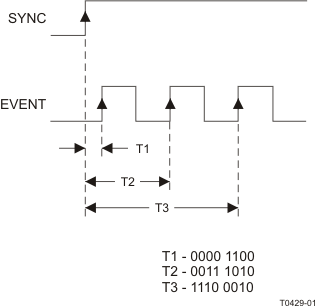SLOS616D March 2010 – March 2015 THS788
PRODUCTION DATA.
- 1 Features
- 2 Applications
- 3 Description
- 4 Simplified Schematic
- 5 Revision History
- 6 Pin Configuration and Functions
- 7 Specifications
- 8 Detailed Description
- 9 Application and Implementation
- 10Power Supply Recommendations
- 11Layout
- 12Device and Documentation Support
- 13Mechanical, Packaging, and Orderable Information
Package Options
Mechanical Data (Package|Pins)
- PFD|100
Thermal pad, mechanical data (Package|Pins)
- PFD|100
Orderable Information
1 Features
- Four Event Channels + Sync Channel
- Single-Shot Accuracy: 8 ps, One Sigma
- Precision: 13 ps
- Result Interface Range: 0 s to 7 s
- Event Input Rate: 200 MHz
- Programmable Serial-Result Interface Speed:
75 MHz to 300 MHz - High-Speed Serial Host-Processor Bus Interface: 50 MHz
- High-Speed LVDS-Compatible Serial-Result Bus per Channel
- Programmable Serial-Result Bus Length
- Temperature Sensor
- Single 3.3-V Supply
- Power: 675 mW per Channel, 18 Bits, 300 MHz,
Four Channels
2 Applications
- Automatic Test Equipment
- Benchtop Time-Measurement Equipment
- Radar and Sonar
- Medical Imaging
- Mass Spectroscopy
- Nuclear and Particle Physics
- Laser Distance Measurement
- Ultrasonic Flow Measurement
3 Description
The THS788 device is a four-channel timing measurement unit (TMU) that incorporates a time-to-digital converter (TDC) architecture for fast and accurate measurements. The TMU can provide 8 ps of single-shot accuracy. The TDC has a 13-ps resolution (LSB), which is derived from an external master clock of 200 MHz. The TDC uses fast LVDS-compatible interfaces for all of its event inputs and serial result outputs, which allows for fast and reliable data transfer. Each channel can process timestamps at a maximum speed of 200 MSPS.
The THS788 device has a wide range of programmability that makes it flexible in different applications. The serial-result interface has programmable data length, frequency, and data-rate mode (DDR and normal). The event channels can be programmed to take timestamps on rising edges or falling edges. The TMU has a mode for event management, in which the user can program wait times before measurements. This programming is achieved through a 50-MHz LVCMOS interface.
The THS788 device is available in an HTQFP-100 package with a heat slug on top for easy heat-sink access. The device is built using TI's RF SiGe process technology, which allows for maximum timing accuracy with low power.
Device Information(1)
| PART NUMBER | PACKAGE | BODY SIZE (NOM) |
|---|---|---|
| THS788 | HTQFP (100) | 14.00 mm × 14.00 mm |
- For all available packages, see the orderable addendum at the end of the data sheet.
4 Simplified Schematic
